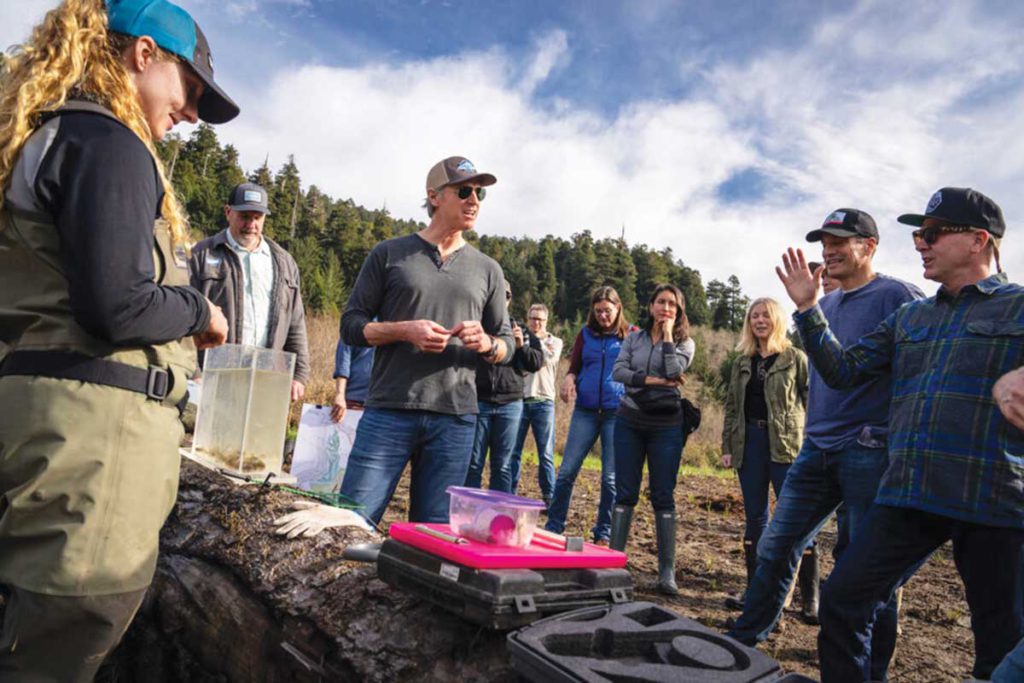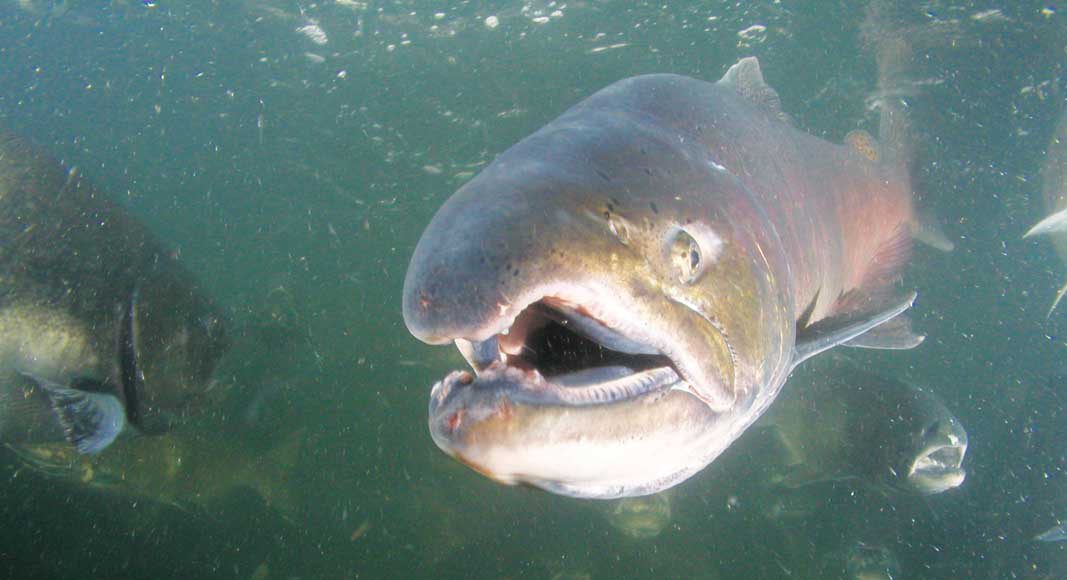As California’s native Chinook salmon populations dwindle, prompting a shutdown of the fishing industry, environmentalists are pleading with water supply managers for a change of course that they say could save the keystone fish.
On Earth Day, several dozen people gathered on the sidewalk outside San Francisco City Hall to demand that the city’s water provider revise its system for capturing flows from the Tuolumne River, a San Joaquin River tributary and a major source of peninsula water supplies.
“Their terrible water policies don’t just harm the environment, but they harm people and communities,” said Peter Drekmeier, policy director with the Tuolumne River Trust, an environmental advocate.
Drekmeier’s beef with the San Francisco Public Utilities Commission goes back years and rests on the premise that the agency stores far more water than it needs in Hetch Hetchy Reservoir, on the upper Tuolumne, at the expense of the river downstream. The commission’s water management plan is based on the unlikely possibility of an 8.5-year drought—a theoretical disaster dubbed the “design drought” that critics consider overkill.
He cited an analysis that concluded such a drought might occur once in 25,000 years. The commission, which ordered the report, said those results were flawed and cannot be trusted for management decisions.
Environmentalists insist the agency could take a more fish-friendly approach, releasing more water through O’Shaughnessy Dam into the Tuolumne River while still providing adequate supplies for its 2.7 million customers. Just cutting the design drought short by 18 months—to seven years—would make all the difference to the fish, Drekmeier said. He and other environmentalists insist that higher average flows through the Tuolumne and into the San Joaquin would boost salmon numbers.
San Francisco resident and retired botanist Mary Butterwick held a sign on the City Hall steps that read “Honor Tribal Rights.” She said she feels the city of San Francisco has captured a water resource that belongs to others.
“The salmon have the senior water rights,” Butterwick said.
But today, San Francisco and two farming districts in the northern San Joaquin Valley control most of the river’s water. Together, the partners deprive the lower Tuolumne of so much flow that in most years, during key life stages for salmon, it trickles like a creek. This aggressive use of the river comes against the recommendation of California water officials, who in 2018 recommended substantially higher flows in the San Joaquin river system to revive the ecosystem.
The utilities commission and irrigation districts answered by suing the state three years ago. In March, a judge with the Sacramento Superior Court tossed out the lawsuits.
Nancy Crowley, press secretary with the San Francisco Public Utilities Commission, said the city’s water agency is reviewing the decision to determine its next steps.
At an April 23 commission meeting immediately following the sidewalk rally, a procession of speakers representing fishers, tribes, NGOs and disadvantaged communities publicly urged the commissioners to accept the court decision and boost the Tuolumne’s flows.
Farm groups and their lobbyists—and the San Francisco Public Utilities Commission—tend to downplay the ecological impacts of taking water from rivers.
Cintia Cortez, policy analyst with the group Restore the Delta, said the commission’s water management plan is formulated after racist statewide policies that “displaced tribes from their ancestral homelands.” She said communities downstream from the Tuolumne must contend today with the results of reduced flows, including toxic algal blooms.
Michael Frost, a board member with the same organization, called the city’s water policies “rapacious,” blaming the commission for the breakdown of a biodiversity hotspot and the largest estuary ecosystem in the West.
“We are at extinction levels of salmon,” he said.
Decline
Before European Americans swarmed California, adult Chinook salmon returned to spawn in the Sacramento and San Joaquin rivers in legendary numbers, with estimates suggesting runs of 1 to 2 million fish each year. The Tuolumne River’s annual contribution to this salmon population amounted to tens of thousands—maybe more.
In the past decade, the Central Valley’s Chinook runs have averaged around 150,000, mostly fall-run Sacramento fish. Just 186 adult Chinook returned to the Tuolumne in 2021, with a promising jump to more than 1,100 in 2023.
The Chinook decline, which has culminated in closure of the state’s salmon fishing season the last two years, has fueled decades of feuding between stakeholders. Fishery proponents contend that state policies unevenly distribute California’s water resources. Farms, they say, get unfair priority, ultimately taking from Central Valley rivers more water than aquatic ecosystems can handle.
“The water policies of California are decimating the fish,” said Scott Artis, the executive director of the Golden State Salmon Association.
Farmers and their allies in the legislature hotly contest this allegation, frequently arguing that farms don’t receive nearly enough water. Two weeks ago, Rep. David Valadao, of San Joaquin Valley, spoke on the House floor, urging the U.S. Bureau of Reclamation to increase water deliveries to the region’s farms.
“Food security is national security, and our ability to grow food for the nation will not survive without reliable water supply for south-of-Delta agriculture,” Valadao said.
But surface water shortages are often mitigated by groundwater pumping. In fact, state crop reports show record hauls of valuable nut and grape crops year after year for decades, with drought periods having little to no impact on harvest. Recent dips in price have resulted largely from oversupply.
Last year, Gov. Gavin Newsom outraged environmental watchdogs by dismantling basic protections on minimum environmental flows through the Sacramento-San Joaquin Delta to allow water managers to store more of the resource in upstream reservoirs. Critics said the action would mostly benefit growers. Similar waivers were issued in prior years, and every critically dry year in the last decade.
Another pattern that has agitated salmon proponents is the repeated failure of state and federal officials to maintain a flow of cold water—vital for spawning salmon—downstream of Shasta Dam and Lake Shasta, the state’s largest reservoir. This happens, critics say, when the Bureau of Reclamation releases too much water during the spring and summer irrigation season. Lake levels drop, and water temperatures climb. This process has killed almost all the fertilized salmon eggs and juveniles in the Sacramento River in recent years.
Fishery advocates saw the subsequent collapse coming.
“There is nothing surprising here,” said Barry Nelson, a water policy consultant to the Golden State Salmon Association. “When you kill almost all the babies, you get dismal returns three years later.”
Strategy

In January, Newsom cited this problem in his “California Salmon Strategy,” a 37-page brochure of proposed recovery actions. It says state agencies and partners will … “[b]y 2025, where appropriate, revise and modernize approaches for Shasta Reservoir management to protect water quality and temperature management for salmon.” The document offers caveats, notably that actions must be considered “in light of other competing beneficial uses of water.”
The number-one competitor for Shasta’s water is agriculture.
Farm groups and their lobbyists—and the San Francisco Public Utilities Commission—tend to downplay the ecological impacts of taking water from rivers. More frequently, water supply advocates blame invasive species, pollution, dams, habitat loss, climate change, poor ocean productivity and overfishing for the breakdown of the Central Valley’s salmon populations.
All of these are plausible factors with known impacts to salmon. In fact, commercial harvest in 2022 probably significantly dented that fall’s spawning returns. That summer, the commercial fleet caught far more salmon than fishery managers anticipated. It was also more than they could sell. Sources said that heaps of Chinook salmon rotted on boats.
Still, most scientists lean on river flows, not fishing pressure, as a key driver of salmon numbers. Historical records of annual precipitation and salmon returns reflect this relationship.
“Every year, nature does an experiment for us … and there’s a very strong pattern where every time flows are high, we get a higher percentage of eggs turning into juveniles, and we get more fish returning three years later,” said Jon Rosenfield, science director at the group San Francisco Baykeeper.
This pattern is not just a correlation, he added, as “there are mechanisms [related to flow volume] that we know drive fish abundance.”
To help the Tuolumne’s salmon, the San Francisco Public Utilities Commission and its partner irrigation districts have proposed habitat improvement measures through a plan dubbed the Tuolumne River Voluntary Agreement. With the landscape restoration group River Partners, the agencies plan to rebuild 77 acres of floodplain beside the river by 2030. This work will be complemented by the addition of 100,000 tons of gravel, the substrate in which salmon lay and fertilize their eggs.
But these measures may have their weaknesses. For one, there is a question about the need for enhanced spawning habitat. In 2008, state and federal fishery biologists found that productive nursery habitat for juvenile salmon in the Tuolumne was, at the time, a greater limiting factor on the river’s salmon production than spawning success.
“[P]roducing more fry by restoring spawning habitat is unlikely to increase adult recruitment,” the scientists wrote in a report.
And restored floodplains do little good unless they are routinely submerged for extended periods—what some say the city’s flow plan for the Tuolumne will fail to do.
“Is it really habitat if there’s no water?” Artis asked.
The city’s voluntary agreement includes actions that specifically address this concern. For instance, it proposes lowering the level of floodplains to facilitate inundation by the river and fish access.
It also calls for added water—but not enough, critics say. State wildlife officials suggested in 2013 that the San Joaquin system be maintained at an average of 60% of all the water in the watershed at a given time—a measure called unimpaired flow. This, they said, would serve as a foundation for restoring salmon runs. In 2018, the State Water Resources Control Board proposed a compromised target of 40% unimpaired flow.
But that number remains a distant goal post. Most years, the Tuolumne’s unimpaired flow ranges between 10% and 20%, while years’ worth of stored water lie idled in Hetch Hetchy. The voluntary agreement will result in an average unimpaired flow of 16%, according to a 2023 analysis by Greg Reis, a staff hydrologist with The Bay Institute.
Such meager flows result in sluggish, warm water downstream of the river’s dams, and it often leaves valuable floodplain habitat high and dry.
Rosenfield, with Baykeeper, noted that even 40% unimpaired flow still tends to be inadequate in California salmon rivers.
“At numbers over 50%, you really start to see more frequent benefits of flow,” he said.











